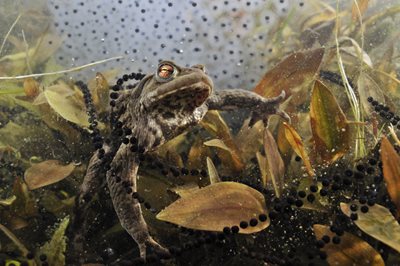Norfolk is the only county with representatives from all our native amphibian species, and early spring is a great time to see them says NWT reserves officer Robert Morgan.
It seems that every February a ‘fools-spring’ deceives us into thinking winter is over. But, as sure as night follows day, March brings us an Arctic blast, even snow on occasion. But despite the season’s vagary, it is such a special time, for who cannot find joy in its arrival however hesitant its faltering start.
I felt my first twinge of spring this week, and it was delivered by an unlikely courier. It wasn’t brought on by the drooping white heads of snowdrops, or the yolk yellow winter aconites that bloom alongside. It wasn’t even an early daffodil or the repetitive bicycle pump squeak of the great tit. For my new, and now favourite, herald of spring is the common toad. I discovered a rather grumpy looking individual emerging from leaf litter at the bottom of the garden. Presumably having just woken from hibernation and en route to my garden pond. Its progression across the lawn can only be described as ‘lumpy’. After what appeared an exhausting three- or four-yards journey, it flopped back on its haunches and with a defiant Churchillian look upon its face, held its chin proudly in the air. It was clearly relieved to have survived the winter and was no doubt delighted that spring had returned.
Prompted by my toad encounter I was reminded of an essay by George Orwell. Better known for his dystopian novels and social commentary, Orwell was also an observant and knowledgeable amateur naturalist. All springs are special, but some are more special than others, particularly so the spring of 1947 when Orwell penned his ‘Ode to spring’. It followed one of the coldest winters of the twentieth century and was, of course, shortly after the end of World War Two. Being closer to the reality of his time, he discarded the sentimentality of Wordsworth or Shelley and chose instead the common toad as his harbinger of spring. “Before the swallow, before the daffodil, and not much later than the snowdrop, the common toad salutes the coming of spring…” I must agree with Orwell, the toad is to be admired, and despite the blemished skin of warts the creature is strangely alluring; their gleaming copper eyes sit in contrast to a blunt insolent expression. They live for years, even decades, but when spring calls them, often on a dark damp night, they will cross over roads, railways and housing estates to get to their ancestral ponds. Some toad migration routes could be centuries old, formed long before the modern world encroached upon them. Fortunately, there are teams of volunteers armed with buckets, torches and hi-visibility vests to help toads traverse busy roads in spring. Toad pancakes are an upsetting sight for anyone.

Common toad (c) Linda Pitkin
Orwell could have paid a spring homage to any of our amphibians, as the toad’s cousins, frogs and newts, are equally early risers and despite being cold blooded appear to cope exceptionally well with the fluctuations of early spring temperatures. The common frog is often the earliest to spawn and appears earlier each year. It is not uncommon now for frogs to spawn during a mild February, and reports of frogs spawning in ponds at Christmas is not uncommon. This early spawning is to avoid the attention of grass snakes, as they tend to have a bit more of a ‘lie in’. This is a risky strategy, but frog spawn is quite hardy and can tolerate several days of frost.
Frogs are not the only amphibians spawning in your pond in spring, if you have common frogs, you are likely to have smooth newts too (although none are keen on ponds heavily stocked with fish). The smooth newt is quite an attractive creature, the male has a crested tail that it waves to allure a mate, and contrary to popular belief are quite sober. The female lays her eggs individually, she wraps them very carefully with her dexterous rear feet in a pond-weed leaf.
Spring is a fantastic time to see, and hear, amphibians, and there are several other native species, all of which can be found in Norfolk (and a few non-native species peppered about the UK too). Our county has the palmate newt and is also a stronghold of the declining great crested newt, an animal that carries some undeserved notoriety among developers. We also have the rare and specialised natterjack toad, which is only found on heaths and coastal dunes, with Norfolk being home to a significant portion of the British population. The gem in the county’s amphibious crown is the pool frog. Recently re-introduced after becoming extinct in Britain, a strong and growing colony can be found at Norfolk Wildlife Trust’s Thompson Common reserve. The unique ‘pingo’ ponds of Thompson Common were the last known site of this rare species, so it is fitting that they have returned and thriving there once again. Unfortunately, the county’s amphibians have suffered due to the loss of natural ponds, and having permeable skin means they are highly susceptible to pollutants. Providing even a modest garden wildlife pond can play an important part in the recovery of our frogs, toads and newts.
Spring can often take her time to get ready, she is caprice and changeable, sometimes turning a cold shoulder other times hot with temper, but as with my garden toad, I love her - warts and all.
Header image - common toad by Nick Upton